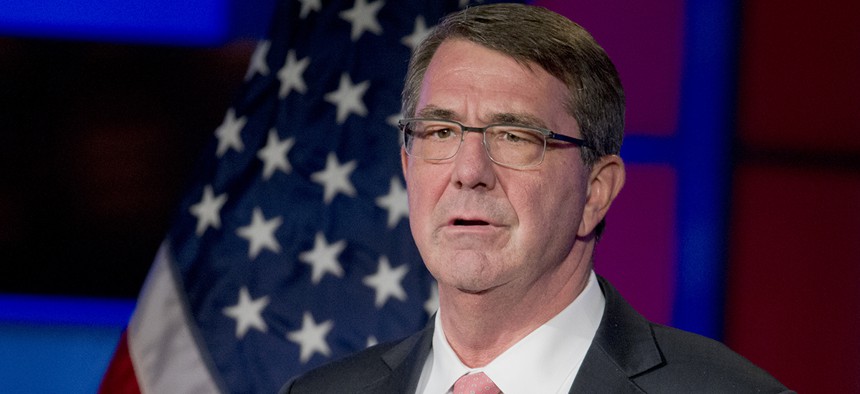Pentagon Rolls Out New Office Devoted to ‘People Analytics’

Defense Secretary Ash Carter Manuel Balce Ceneta/AP
A first tranche of reforms omits some highly anticipated fixes, but seeks to lay the groundwork for more.
Of all the military-personnel reforms announced Wednesday by Defense Secretary Ash Carter, the most important might be the one that doesn’t immediately change anything for the troops.
A new Office of People Analytics will collect and interpret data about how service members are performing and why they decide to leave. Among other things, the military will start conducting formal exit interviews with troops getting out.
“For some reason, we’ve never comprehensively done that before,” Carter said in a speech at George Washington University. “While there have been studies, articles, and entire books written about how the military is ‘bleeding talent,’ most of these are anecdotal. And because DoD hasn’t been gathering the data, we couldn’t quantitatively prove or disprove it, let alone fix it.”
The new office is part of Carter’s Force of the Future effort, which he launched upon taking office in April and is now producing its first fruit. It aims to convert the military’s legendarily rigid personnel system into a flexible organization that attracts, keeps, and makes best use of the cream of American talent in an era when spouses work, many top performers change jobs every few years, and civilian experience can be vital to military operations in an ever-more-networked world.
Mieke Eoyang, who runs the national security program at Third Way, a Washington think tank, says Carter’s plan ultimately could prove as revolutionary to the military as the transition to the all-volunteer force — but it all starts with knowing more about your people.
Source documents:
- Carter’s Nov. 18 speech, as prepared for delivery
- Carter’s Nov. 18 memo on the reforms
- Force of the Future fact sheet
“Data collection is a necessary foundation for going forward,” said Eoyang, a former Armed Services Committee staffer in Congress who has helped steer legislative and military policymakers through buildups and drawdowns for years. “There’s little in the way of defining what the talent loss really is. For systemic change of this kind, you need to lay the groundwork, and then make your case to Congress.”
That may be one reason why several highly anticipated reforms — among them a rethinking of the up-or-out and promotion-by-time-served principles — didn’t make the cut for this first batch.
Still, there is plenty to get started on. Among the 12 new initiatives Carter announced are:
- Expand and make permanent a program that allows troops to get out of the military for a few years and return without hurting their careers.
- Introduce portable 401(k)-type accounts that will allow servicemembers — finally — to accrue retirement benefits immediately, just like many private or federal jobs.
- Stand up a DOD Digital Service to move quickly on IT ideas and problems. The team will be modeled on the U.S. Digital Service launched by the White House after the Healthcare.gov debacle.
- Allow more officers, and now senior enlisted troops, to serve a tour of duty at a corporation (“places like Microsoft, Amazon, SpaceX, and Accenture,” according to a Force of the Future fact sheet).
- Create an “Entrepreneur-in-Residence” program that pairs private-sector people with senior service and DOD leaders.
- Catalog the civilian skills held by military reservists.
- Create a DoD-wide chief recruiting officer.
- Add internships for college students at the Defense Department.
And Carter promised more to come.
“For example, we’re taking a serious look at making some common-sense reforms to our officer promotion system. We’re also looking at ways to improve how we manage our civilian personnel, working with the government-wide Office of Personnel Management as well as federal employee unions,” he said.
And how are the services reacting to all this? According to senior DOD and service officials in background briefings and private conversations, they’re not only supporting these kinds of changes, they’re asking for them.
Eoyang said she’s seen that as well.
“The Navy and Air Force have been working really broadly with the think tank community to identify out-of-the-box thinking about personnel reform,” she said. “This is not social engineering driven from the top. These are things the services are demanding, and pushing up to a receptive political audience. The uniforms are saying, ‘We’ve got to do this in order to retain talent,’ based on their lived experience.”
The real questions, she said, concern what happens in 2017 and beyond, after Carter vacates his E-Ring office for a successor.
“Does a future administration recognize that these are changes that need to happen?” Eoyang said. “Or does it think you can go back to an Ozzie and Harriet world while service members are living in a Modern Family era?”



